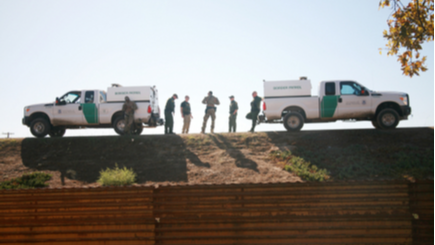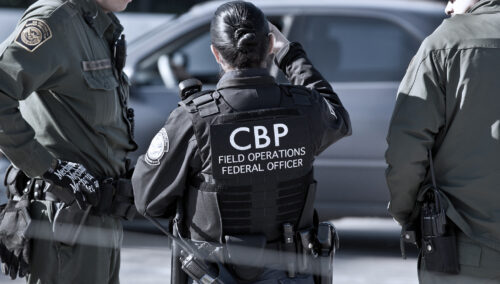When President Biden took office in January 2021, he promised to transform how the United States treated asylum seekers and restore the humanitarian protections devasted by his predecessor. But by the end of 2021, as apprehensions hit levels not seen in 20 years and over 1.5 million people arrived at the border and crossed for the first time, Border Patrol agents carried out over 1,000,000 expulsions and deportations, including the mass expulsion of Haitian migrants to a country that the United States had just said weeks earlier was too dangerous for deportations. This fact sheet aims to provide historical context for the events of 2021, explain the roots of the rise in border apprehensions during the year, and analyze how the Biden administration responded.
Although much of the national focus in 2021 was on the arrival of families and unaccompanied children, headlines about “the highest number of border encounters in 20 years” were the result of trends among an entirely different group—single adults—who were responsible for more than half of all border apprehensions that year.
For generations, the United States has seen periodic cycles of migration. There have also been multiple extraordinary migration events that have led more families and children to seek asylum. Although many commentators have blamed the Biden administration alone for the rise in border encounters in 2021, the roots of the current trends began months—and in some cases years—before President Biden took office. The government can and should view the arrival of high numbers of asylum seekers as a humanitarian protection management challenge, not a security challenge.
Historical Background
For nearly a 35-year period beginning in the mid-1970s, the Border Patrol routinely apprehended at least 1,000,000 migrants a year—primarily Mexican single adults—who were seeking a better life in the United States. Seasonal migration patterns led to spikes in apprehensions each spring. For example, from December 1999 to March 2000, apprehensions rose from 71,252 to 220,063. During each of these spikes, many apprehensions were of the same individuals crossing the border multiple times and being sent back to Mexico under a practice known as “voluntary returns.” During these years, patterns of “circular migration” led to many individuals crossing the border to work in the United States for a short period of time before returning home.
Despite the high number of apprehensions, until recently most people crossing the border were able to do so without being apprehended. The U.S. Department of Homeland Security (DHS) estimates that Fiscal Year (FY) 2012 was the first time the Border Patrol apprehended a majority of people crossing the border. Thus, in FY 2000, when the Border Patrol recorded 1.7 million apprehensions, DHS estimates that there were an additional 2.1 million successful unlawful entries.
After the Great Recession in 2007-2008, migration from Mexico declined sharply, falling from 1,089,092 apprehensions in FY 2006 to 340,252 apprehensions in FY 2011. Around the same time, the number of Border Patrol agents increased dramatically under the Bush administration, from 11,264 in FY 2005 to 21,444 in FY 2011. The combination of reduced economic demand and increased immigration enforcement led to a significant reduction in the number of single adults coming to the border—a trend which lasted for the next decade. As economic conditions in Mexico improved and the border became more difficult to cross, circular migration patterns were disrupted and net migration from Mexico dropped significantly, leading to more undocumented immigrants leaving the United States than entering it.
As a result, direct comparisons between apprehension numbers in recent years and those occurring decades ago miss a key fact: it is significantly harder to cross the border without detection and apprehension today than it was just a decade ago (see Figure 1).
Figure 1: Estimated Total U.S.-Mexico Border Crossings, By Outcomes, FY 2000 – 2018
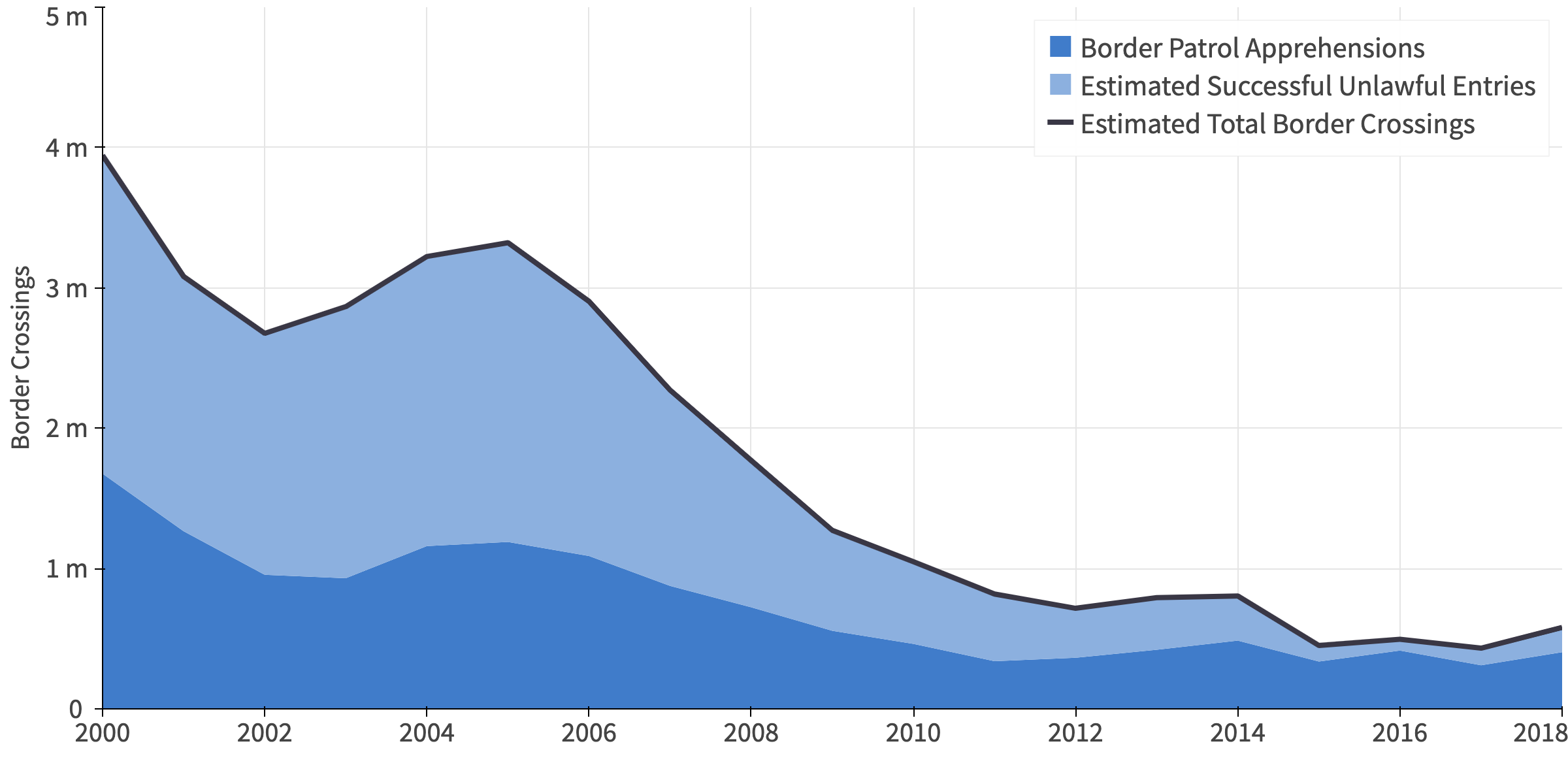
Source: Table 1, Model-Based Apprehension Rate, DHS Office of Immigration Statistics, “Fiscal Year 2019 Border Security Metrics Report” (August 2020);U.S. Customs and Border Protection, Annual Apprehensions FY 1925–2019.
However, the United States began encountering a new phenomenon beginning in 2014 with the arrival of tens of thousands of unaccompanied children and families seeking asylum in the United States. By law, individuals can only seek asylum once they are physically present in the United States or when they are arriving at a port of entry. Asylum seekers and unaccompanied children who are unable to seek asylum at ports of entry generally turn themselves in to the Border Patrol immediately upon crossing the border and ask to access the asylum process. Even when asylum seekers voluntarily turn themselves in to the Border Patrol, they are still recorded as having been “apprehended.”
Both the Obama and Trump administrations attempted without success to deter people from seeking protection, from the former’s expansion of family detention through the latter’s family separation policy. But these policies have not had any meaningful long-term effect despite the tremendous hardship they have created for many families and children. For example, the number of families and children encountered at the southern border peaked in FY 2019, despite the family separation policy the previous year, when the Border Patrol apprehended a total of 549,702 parents and children at the border seeking protection.
While the spike of arrivals in FY 2019 did not bring border apprehensions near the levels of the 1980s through early 2000s (see Figure 2), families and children posed a unique processing challenge for the government as contrasted with single adults, because of laws and court orders mandating specific treatment of children. Nevertheless, the number of single adults encountered at the border in 2019 remained relatively low in comparison to the previous decade.
Figure 2: Annual Border Patrol Apprehensions at the U.S.-Mexico Border, FY 1970 – FY 2021
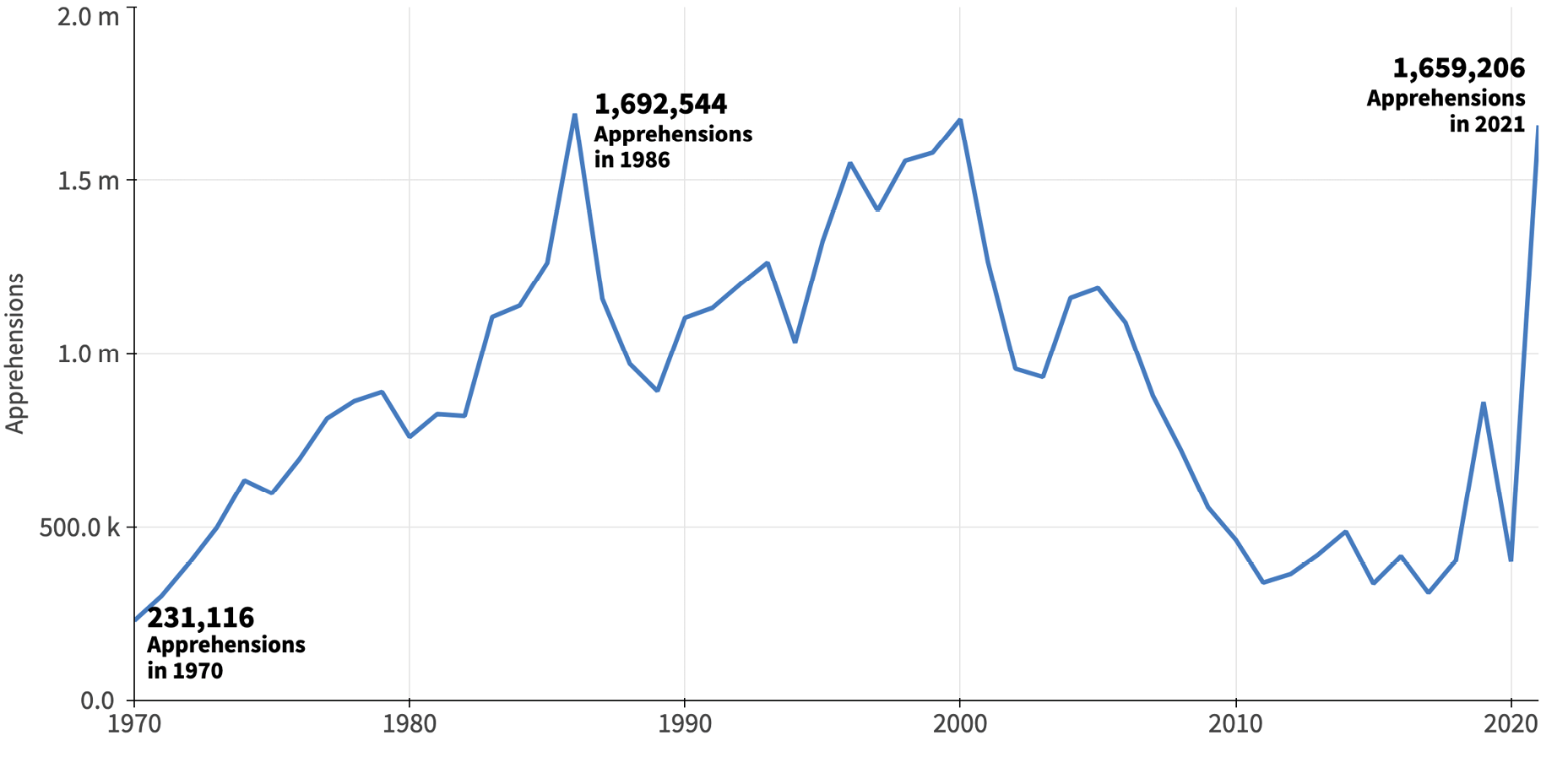
Source: U.S. Customs and Border Protection, Monthly Border Patrol Apprehensions, FY 2000-2020.
At the same time that the government warned people not to cross between ports of entry or they could face family separation, the government was turning asylum seekers away from ports of entry. Before the COVID-19 pandemic, tens of thousands of people intending to seek asylum were waiting in Mexico because of a practice known as “metering” by which CBP limits the number of people who can ask for asylum each day at a port of entry.
By February 2020, there were an estimated 15,000 people waiting for the chance to begin the asylum process in cities across the U.S.-Mexico border, some of whom had been waiting for years. The DHS Office of Inspector General determined in 2020 that metering caused some people to cross the border and turn themselves in rather than wait for unknown periods of times in Mexico for a chance to begin the asylum process through a port of entry.
Border Apprehensions Began Rising in Spring 2020 After Title 42 Went Into Place, Then Increased Even Further in 2021 Amid Growing International Instability
In spring 2020, COVID-19-related lockdowns spread economic chaos across Mexico and Latin America. At the same time, the United States shut its borders to all asylum seekers and President Trump instituted the practice of expelling individuals encountered at the border without allowing them to seek asylum, using a century-old public health authority allegedly provided by Title 42 of the U.S. Code. Under an agreement reached with Mexico on March 21, 2020, CBP began taking any single adult or family from Mexico, Guatemala, Honduras, or El Salvador and immediately expelling them back to Mexico.
Throughout 2020, unaccompanied children, and many individuals from countries that Mexico would not accept, were held in government custody for days or weeks and then expelled by plane back to their home country. In total, more than 13,000 unaccompanied children were expelled under Title 42 until a federal judge ordered the Trump administration to stop the practice on November 18, 2020, declaring it a violation of immigration law.
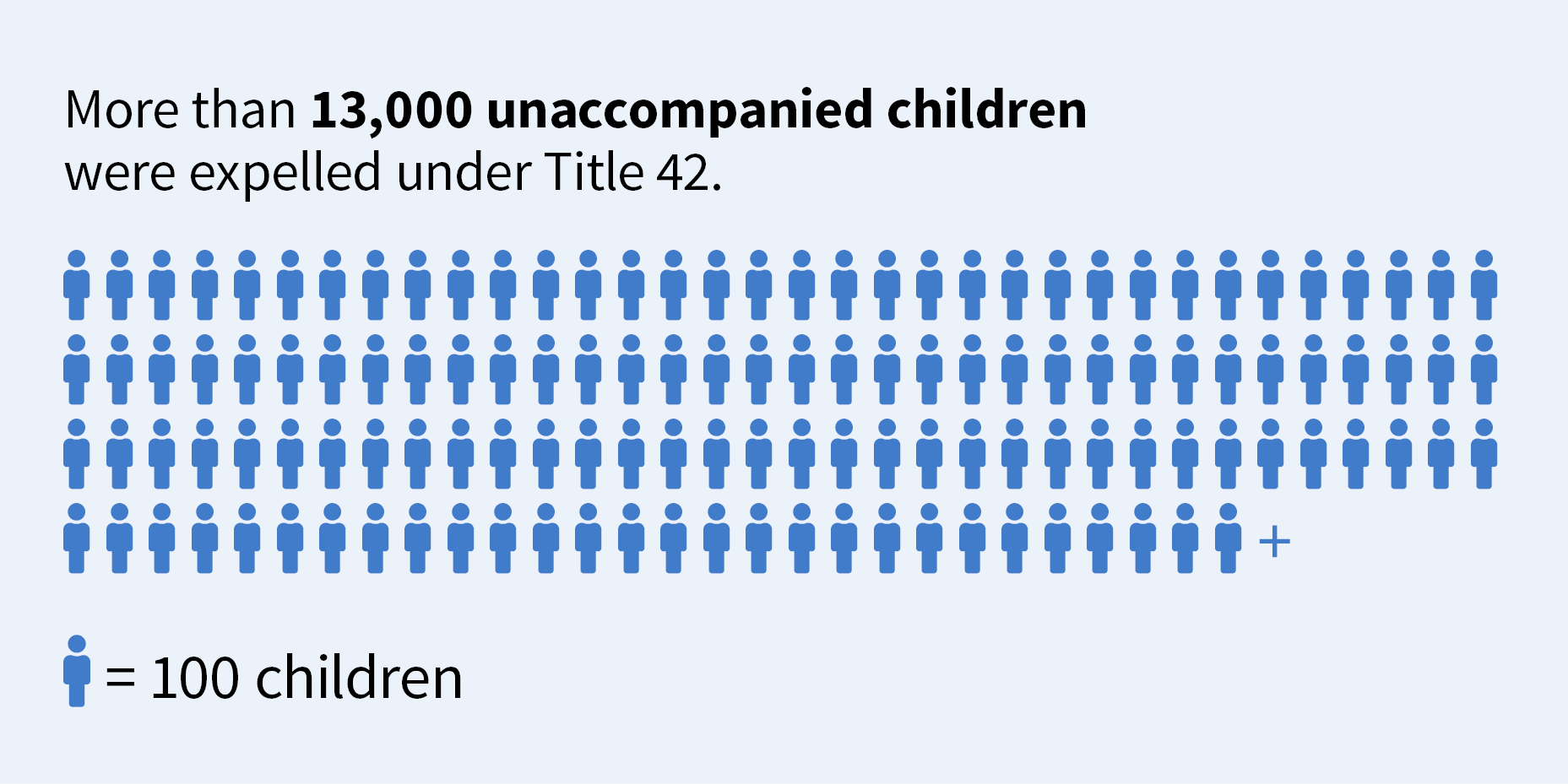
Source: U.S. Customs and Border Protection, “Nationwide Encounters.”
At the same time that Title 42 went into place, the Trump administration eliminated access to asylum at the ports of entry. That left tens of thousands of people on metering lists stranded in Mexico. Those waiting in Mexico to seek protection were left with no option but to continue waiting and hope the border would reopen at some unknown point in the future.
The COVID-19 pandemic also led the Trump administration to suspend court hearings for 25,000 migrants sent back to Mexico under the so-called “Migrant Protection Protocols” (also known as the Remain in Mexico Program). Subsequently, new placements into MPP were almost entirely replaced by Title 42 expulsions, meaning that people would be sent back to Mexico without being placed into any kind of court process. After Title 42 went into effect, just 1.19% of people encountered at the border were put into MPP before the Biden administration took office and fully suspended new enrollments in MPP on January 20, 2021.
Almost immediately after lockdowns lifted across Mexico and Central America, the number of single adults coming to the border seeking to enter the United States began rising rapidly, from a low of 14,754 in April 2020 to 62,041 in December 2020. This was the highest number of apprehensions for a December in 15 years.
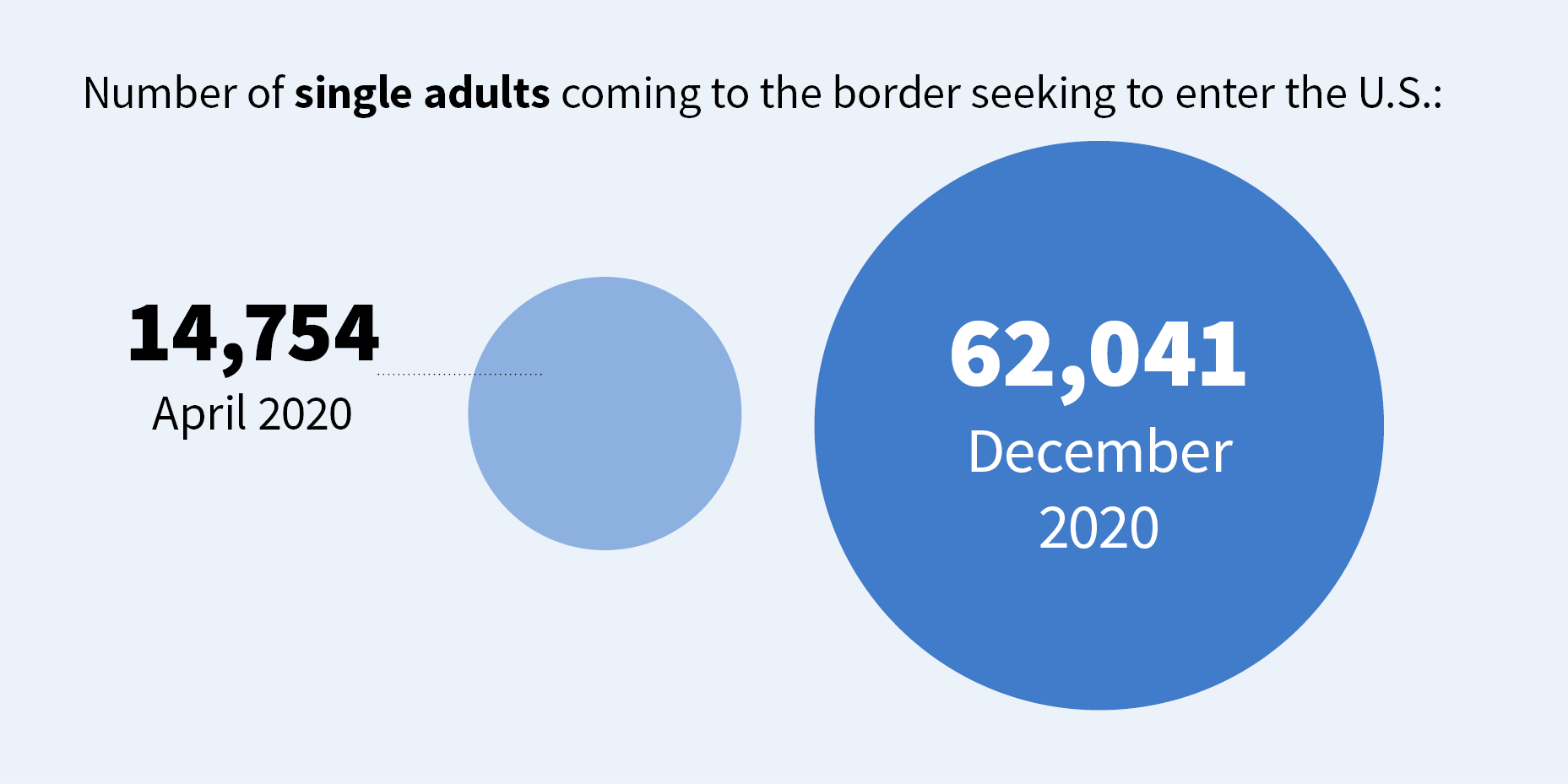
Source: U.S. Customs and Border Protection, “Nationwide Encounters.”
After President Biden took office, the number of asylum seekers and migrants apprehended after crossing the border between ports of entry began rising rapidly, increasing from 75,316 in January 2021 to a high of 200,658 in July 2021. Although the large majority of migrants arriving at the border in the first half of the year were from Mexico, Guatemala, Honduras, and El Salvador, by the end of the year an increasingly large portion came from other countries in the Western Hemisphere, such as Venezuela, Nicaragua, Cuba, Haiti, and Colombia.
The reasons that migrants chose to come to the border in 2021 are as varied at the people themselves. Many individuals from Guatemala and Honduras left because of growing food instability following years of drought and two major hurricanes which hit the countries in 2020 and devastated cropland. In March 2021, the World Food Program declared that millions of Hondurans and Guatemalans were in a nationwide “Crisis level” for food insecurity, with nearly one million people nearing the level of a famine. Violence and impunity also continued to be an issue throughout the region, causing many to leave.
The continuing effects of the COVID-19 pandemic have also fueled migration across the hemisphere, especially among refugees who had previously been waiting in other countries. Due to rising anti-immigrant sentiment and economic insecurity resulting from the pandemic, tens of thousands of Venezuelan and Haitian refugees living in South America became displaced from countries in which they had already sought refuge. Many saw the United States as their best chance to find any kind of permanent security.
Still others left due to escalating political instability and persecution in their home countries. For example, arrivals of Nicaraguans rose dramatically throughout the year as the government of Daniel Ortega cracked down politically and jailed opponents. Asylum seekers from Cuba also increased significantly through 2021, following mass political protests throughout the country and a corresponding crackdown.
But not all those who became displaced in 2020 and 2021 made their way to the United States. The entire region saw rising numbers of refugees. In Costa Rica, a record 53,000 Nicaraguans sought asylum in 2021, compared to 87,000 who sought asylum in the United States. In Mexico, a record 131, 448 people applied for asylum.
Thus, despite the focus on the United States and on the actions of President Biden, migration increased across the entire hemisphere in 2021.
Title 42 Caused A Massive Increase In Repeat Border Crossings, Inflating Apprehension Numbers And Endangering Migrants
Throughout his first year in office, President Biden maintained the single largest border program in use by his predecessor: Title 42. Over the course of 2021, Border Patrol agents carried out 1,111,609 expulsions under Title 42, including over 150,000 parents and children traveling as a family. The broad use of Title 42 has not only had a negative effect on asylum seekers, it also paradoxically served to increase the number of border crossings.
Title 42 has increased border crossings in large part by creating a situation where many people expelled back to Mexico make at least one additional attempt to cross the border.
Under Title 42, the overwhelming majority of single adults are rapidly processed at the border and sent right back to Mexico without a deportation order. This arrangement has incentivized repeated attempted crossings for multiple reasons, including that:
- Many individuals become more desperate following an expulsion, as they lose stability, resources, and often their personal belongings following expulsions. Because the border region remains highly dangerous for asylum seekers expelled back to Mexico, and because the Biden administration has not resumed normal processing of asylum seekers at ports of entry along the border, many people feel as if they have no choice but to make a renewed attempt to seek safety in the United States.
- Due to post-COVID changes made at the Department of Justice in spring 2020, individuals who cross the border for the first time under Title 42 are largely exempt from federal prosecution for misdemeanor “improper entry.” They are also not issued a deportation order. For individuals crossing the border who are not planning on turning themselves in and asking for asylum, this policy eliminates two possible negative consequences of being apprehended by the Border Patrol. As a result, following a failed attempt to cross the border, some individuals are more willing to try again.
The link between Title 42 and an increased rate of repeat crossings has been repeatedly acknowledged by DHS officials. In total, the rate at which people crossed the border multiple times rose from 7% in March 2020 to 40% by October 2020, before falling to an annual rate of 27% throughout 2021 as an increasing number of asylum seekers couldn’t be expelled and made it in on their first attempt.
The phenomenon of increased repeat crossings under Title 42 also created a distorted picture of the total number of people crossing the border. For example, through the first nine months of FY 2021, when CBP recorded a total of 1,119,204 border encounters, the number of “unique encounters” (people who have not been taken into custody in the previous 12 months) was 690,718. By comparison, over the same period in FY 2019, CBP recorded 780,479 border encounters, of which 721,328 were unique encounters—over 30,000 more than in FY 2021.
As migrant encounters continued at a high pace throughout 2021, the number of unique individuals encountered at the border eventually rose above 2019 levels, although not to the degree that simply comparing overall encounters would suggest. Despite nearly twice as many border apprehensions in FY 2021 than in FY 2019, the actual number of people encountered at the border was only 45% higher (see Figure 3).
Figure 3: Estimates of Unique Apprehensions, FY 2005 to December 2021
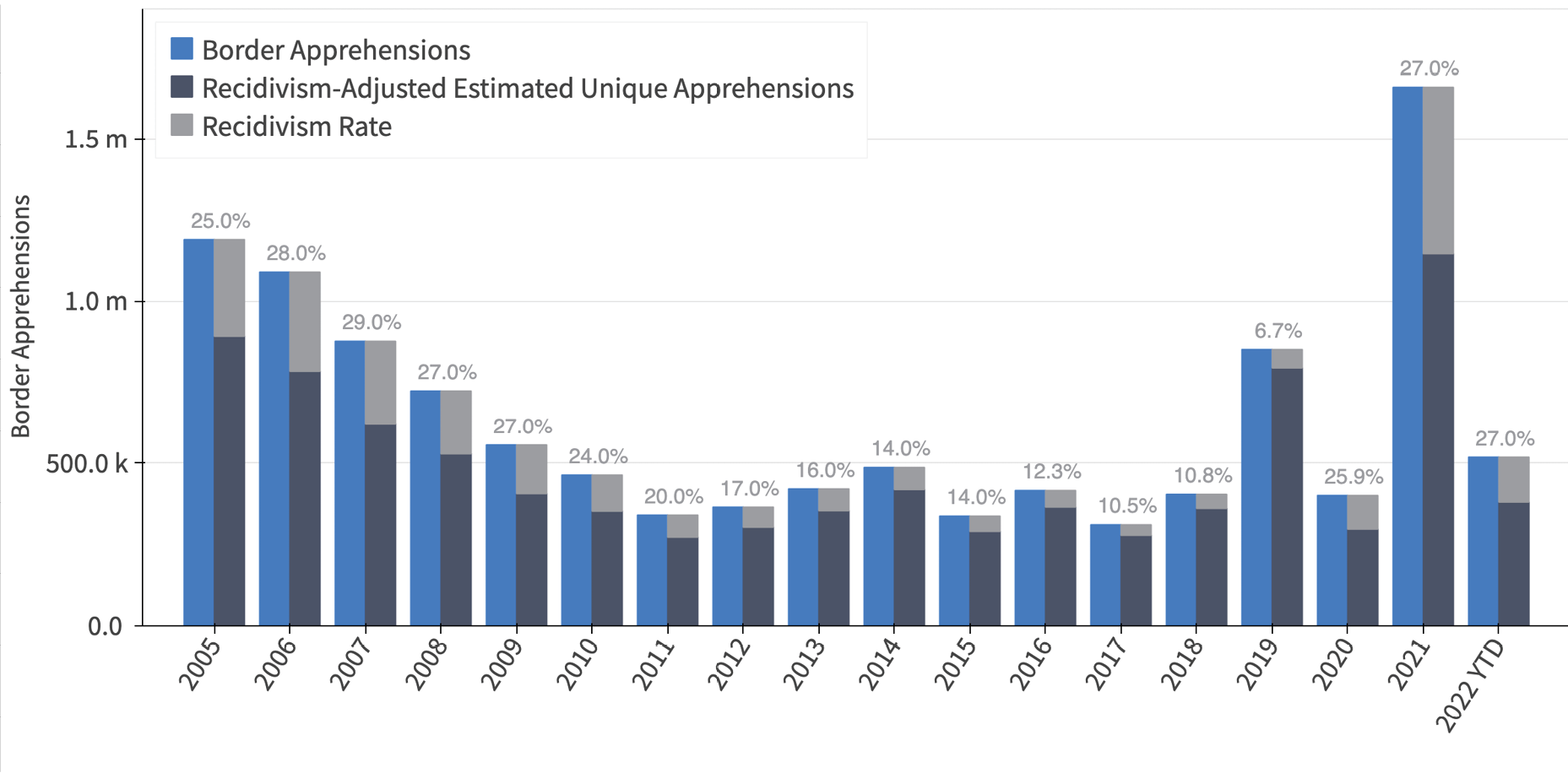
Source: U.S. Customs and Border Protection, Congressional Budget Justifications, FY 2008-2022; Monthly Border Patrol Apprehensions, FY 2000-2020; data on file with author.
The Majority of People Encountered and Expelled at the Border in 2021 Were “Single Adults”
Throughout 2021, nearly all individuals taken into custody and classified as “single adults” by the Border Patrol were expelled back to Mexico. This caused many to cross repeatedly, with some individuals reporting that they tried and failed to cross the border dozens of times. In total, 57% of all people who were taken into Border Patrol custody in calendar year 2021 were classified as “single adults” (see Figure 4). Notably, the Border Patrol definition of “single adult” would include some individuals who were travelling together but wouldn’t fall within the Border Patrol’s narrow definition of a family group, such as two unmarried romantic partners, or a grandparent with a grandchild.
As demonstrated by Figure 4, the rapid increase in “single adults” being apprehended at the border began immediately following the COVID-19 pandemic and the implementation of Title 42 in March 2020. Beginning in April 2020, apprehensions in that demographic rose for 14 months straight, peaking at 117,397 apprehensions in May before leveling off at over 100,000 per month.
Figure 4: Border Patrol Apprehensions, October 2012 to December 2021, Single Adults vs. Families and Children
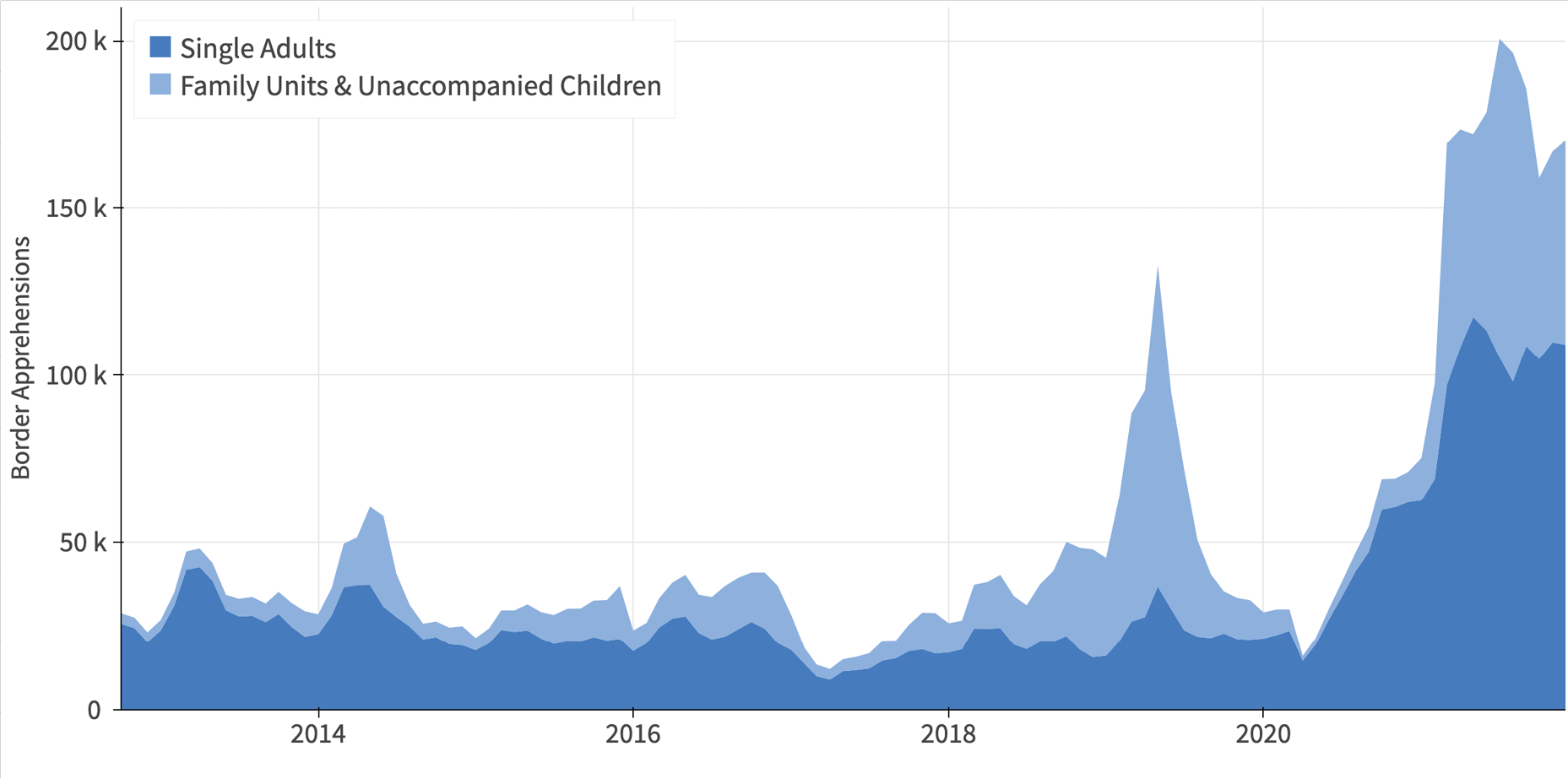
Source: U.S. Customs and Border Protection.
Importantly, there has been a significant human cost to 1.1 million expulsions. For too many in this group, the border was closed tight, and the risks in crossings were higher than ever. Tragically, 2021 was the deadliest year on record for people crossing the southern border. At least 650 people, likely more, died while attempting to cross the border.
What Actually Happened To People Encountered After Crossing the Border?
Over its first year in office, the Biden administration continued the previous administration’s practice of rapidly expelling or deporting most people encountered at the border. From February through December, 56% of all people encountered by the Border Patrol were expelled under Title 42 (see Figure 5). While unaccompanied children and some families at the border have been allowed to come into the country and challenge their deportation in immigration court, they represent just 44% of total apprehensions over that period.
Figure 5: Processing Outcomes of Individuals Encountered by the Border Patrol, February 2020 to December 2021
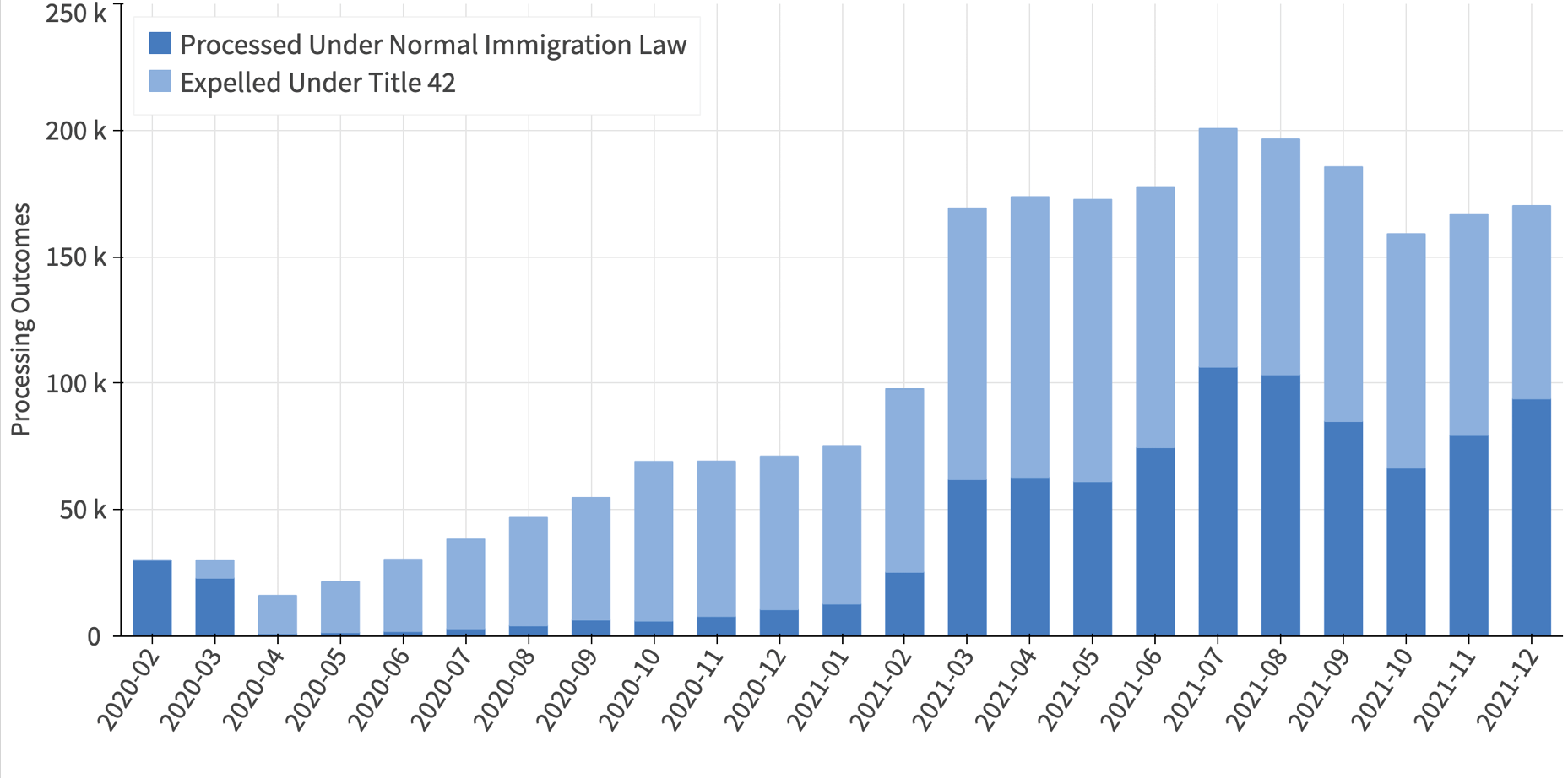
Source: U.S. Customs and Border Protection, Southwest Border Encounters.
Just because an individual or family was not expelled under Title 42 does not mean they were admitted into the United States. Many were sent to ICE detention, or immediately subject to a normal deportation order under Title 8 (see Figure 6).
Data produced by the Department of Homeland Security reveals that in 70.7% of cases, migrants encountered at the border during Biden’s first year in office were either expelled, deported, or sent to ICE detention centers. In total, from February 2021 through December 2021:
- 56.7% of Border Patrol encounters led to an immediate expulsion under Title 42;
- 21.7% of Border Patrol encounters led to a person being released at the border under humanitarian parole, with a notice to report to an ICE office, or with a notice to appear in immigration court;
- 10.7% of Border Patrol encounters led to a person being sent to an ICE detention center or to a state, local, or federal jail for criminal prosecution.
- 7.6% of Border Patrol encounters were of an unaccompanied child who was sent to a shelter run by the Office of Refugee Resettlement.
- 3.3% of Border Patrol encounters led to an immediate deportation.
The eventual fate of those sent to ICE detention remains unclear. Some individuals will have been granted bond or otherwise released, while others have likely been deported. Others may still remain in detention while they seek asylum or otherwise fight their case against removal. Those sent to a penal facility are likely eventually sent to ICE detention after the conclusion of any criminal process.
Figure 6: Individuals Apprehended by the Border Patrol and Not Expelled, October 2012 to December 2021
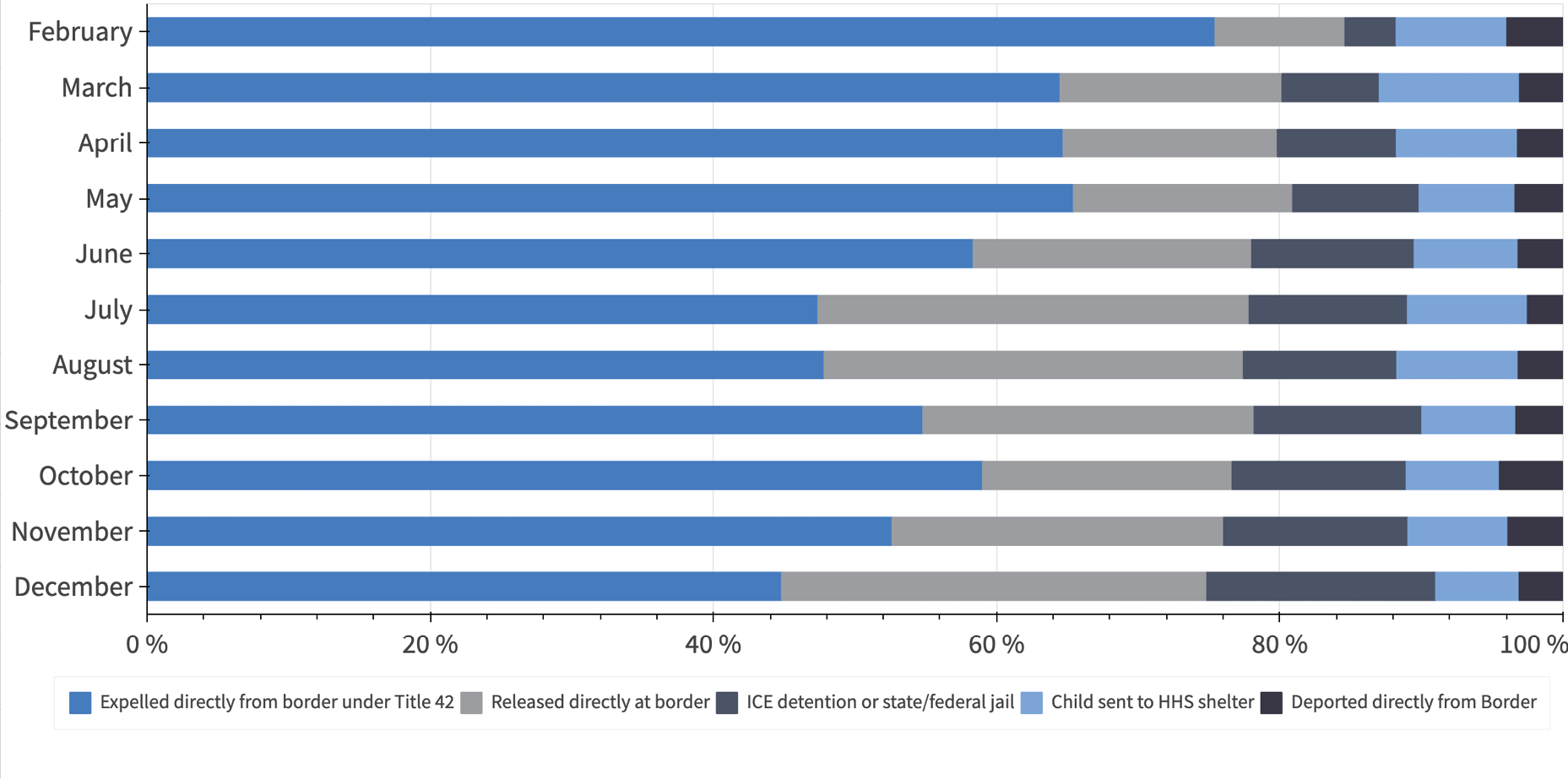
Source: U.S. Customs and Border Protection, Southwest Border Encounters; Status Report, Texas v. United States, 2:21-cv-00067,
ECF No. 124 (January 14, 2021); Status Report, Texas v. United States, 2:21-cv-00067, ECF No. 119 (December 15, 2021).
As a result, despite significantly higher overall encounters at the border, it is likely that in 2021, fewer people were admitted into the United States and placed into normal deportation proceedings when compared to the period of high migration that occurred between 2018 and 2019. That is true even when considering the increased numbers of single adults and a record number of unaccompanied children crossing the border (see Figure 7).
Figure 7: Individuals Apprehended by the Border Patrol and Not Expelled, October 2012 to December 2021
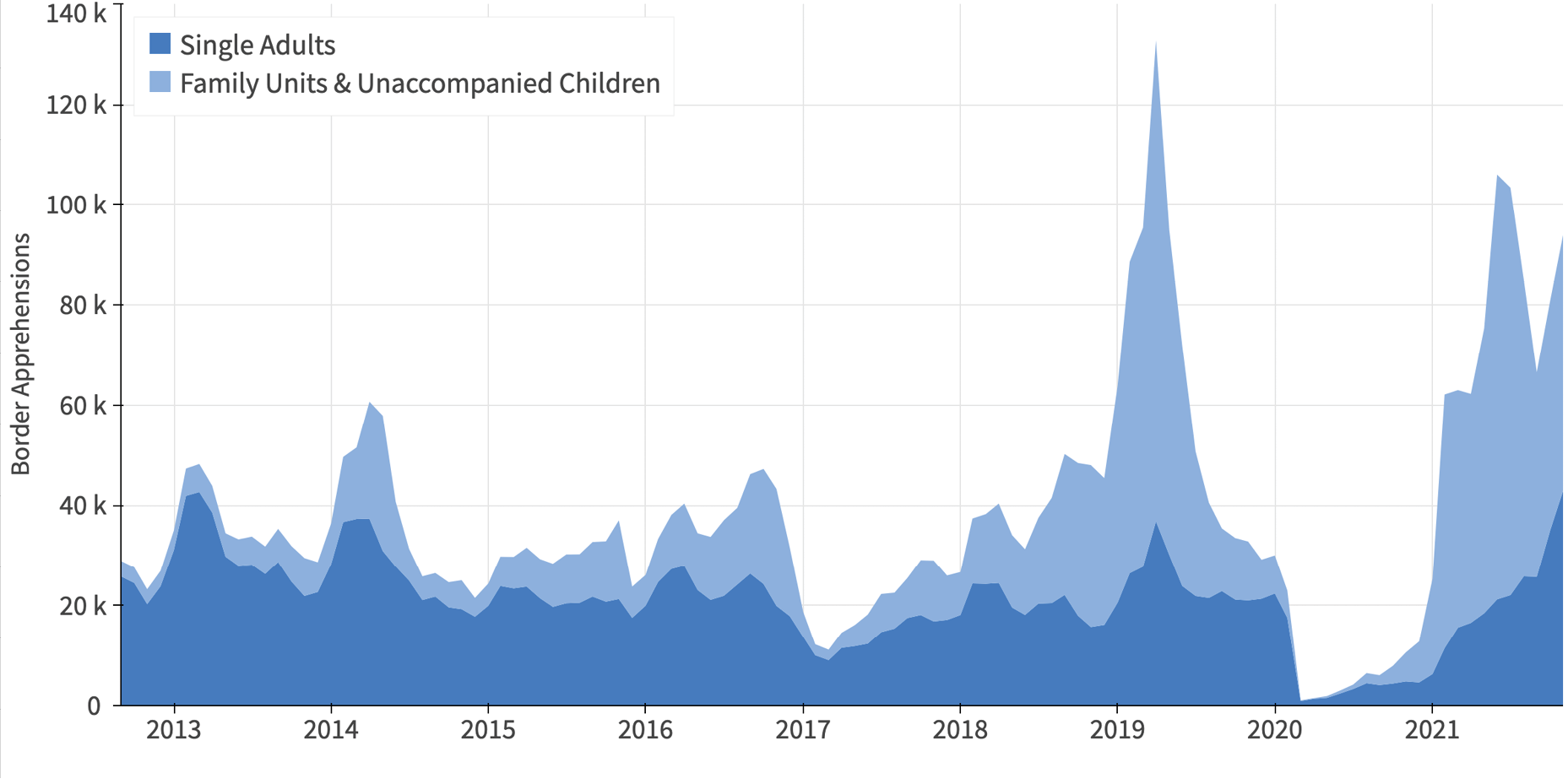
Source: U.S. Customs and Border Protection, Southwest Border Encounters.
Changing Demographics Among Migrants Hindered Biden Administration’s Ability to Expel All Migrants Under Title 42
Despite the Biden administration’s stated commitment to restoring asylum at the border, DHS continued the Trump administration practice of expelling most families, with President Biden himself declaring at his first press conference that “They should all be going back [to Mexico].” However, in practice the Biden administration struggled to expel many people.
The two main reasons that hundreds of thousands of migrants were not expelled were primarily diplomatic and logistical; either there was not a country where a person could be expelled to, or there was simply not enough capacity for DHS to carry out the expulsion.
The Biden administration was unable to expel most families in 2021
The first demographic that the Biden administration struggled to expel was families who were crossing the border in south Texas. Three days after President Biden took office, immigration officials in the Mexican state of Tamaulipas (which borders south Texas), told the Biden administration that it would not accept the expulsions under Title 42 of Mexican, Guatemalan, Honduran, or Salvadoran parents with children under the age of 7.
As a result of Tamaulipas’ refusal to accept the expulsion of families with young children, when the numbers of families arriving at the border in south Texas began rising in early February the Biden administration was unable to expel the majority under Title 42 and was forced to release thousands of families. Likely as a result, the number of families crossing the border in south Texas rose significantly in spring 2021.
By contrast, Mexican immigration officials in Chihuahua (bordering El Paso) permitted CBP to expel families under Title 42, regardless of the age of their children. This difference in processing may explain why families seeking asylum, by and large, avoided crossing the border in El Paso. This stands in stark contrast to 2019, when families crossed the border in both locations in large numbers (see Figure 8).
Figure 8: Family Units Apprehended by Border Patrol, by Sector, October 2016 to December 2021
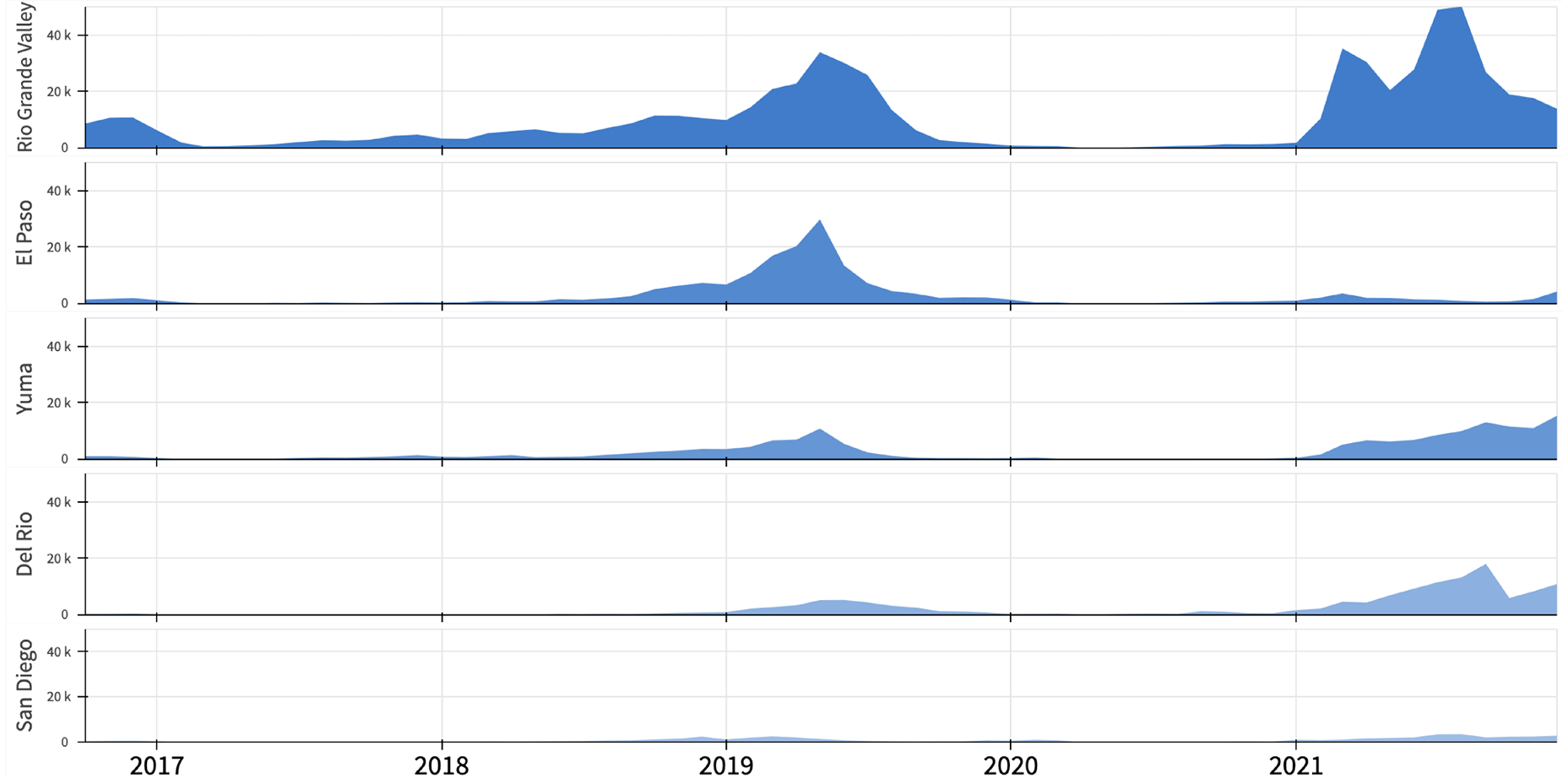
Source: U.S. Customs and Border Protection, Nationwide Encounters.
The Biden administration tried to circumvent the issues with expelling families to Tamaulipas by flying some families or single adults apprehended in Texas to other places along the border and expelling them there. Families expelled this way described feeling “tricked” by Border Patrol agents who told them they would be released, only to discover at the last second that they were being sent back to Mexico. In April, ICE flew 60 flights from South Texas to either El Paso or San Diego, with at least 100 families on board to be expelled on each flight, meaning at least 6,000 people were “laterally expelled” in one month.
Despite the use of these lateral expulsions, the majority of families who arrived at the border in 2021 were able to remain and seek asylum without being expelled (see Figure 9). Due to the Trump and Biden administrations’ policy of expelling families back to Mexico, along with both administrations’ refusal to reopen the ports of entry for asylum processing, refugee camps began springing up across the border in places like Tijuana and Reynosa.
Human rights advocates documented thousands of cases of violence and criminal behavior carried out against families expelled to Mexico under Title 42. Despite the obvious dangers caused by repeat expulsions, the Biden administration insisted that Title 42 is actually something that protects migrants.
Figure 9: Family Unit Apprehensions, January 2018 to December 2021, By Processing Outcome
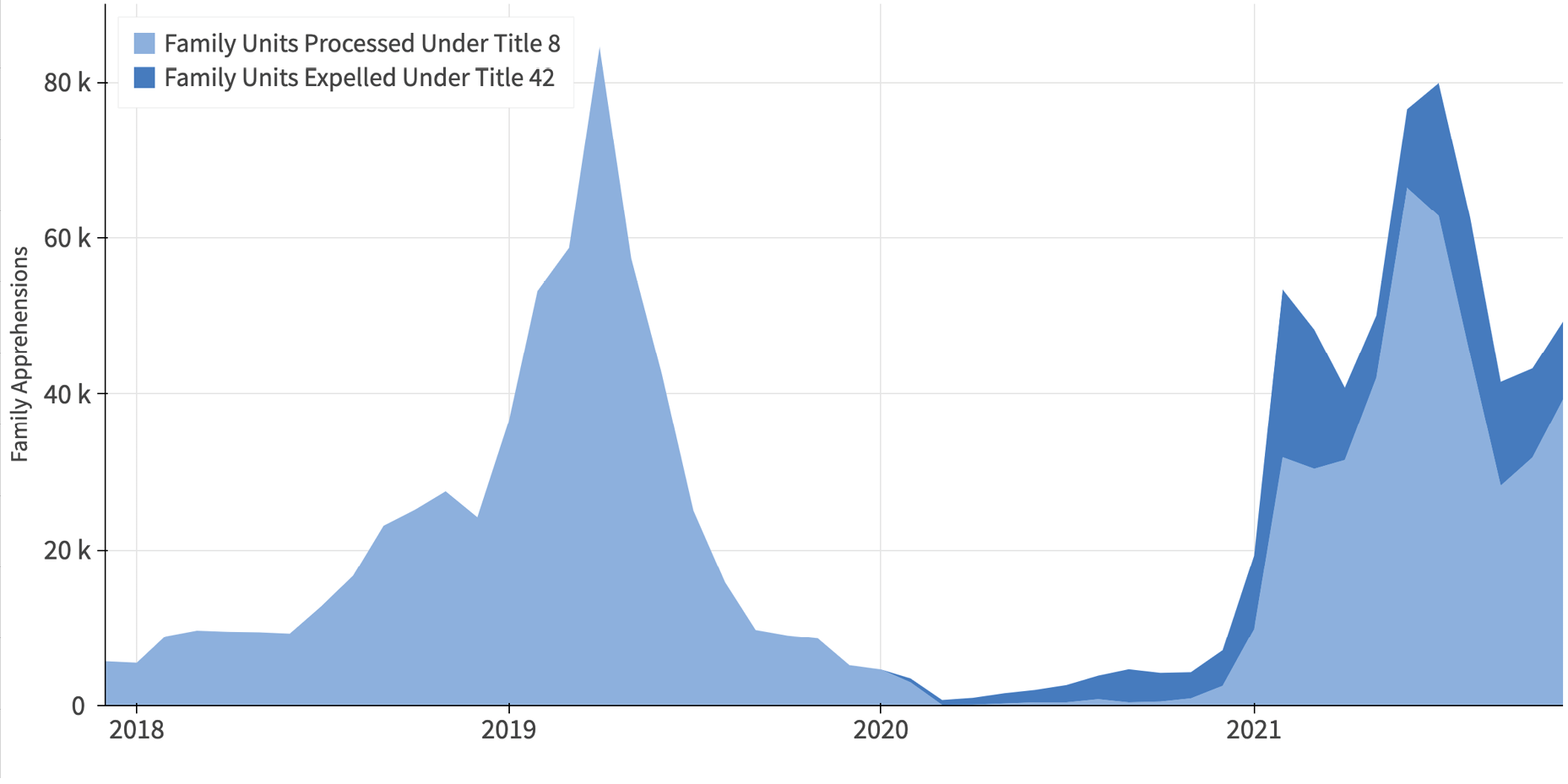
Source: U.S. Customs and Border Protection, Nationwide Border Encounters.
The Biden administration was unable to expel the vast majority of individuals from countries other than Mexico, Guatemala, Honduras, and El Salvador in 2021
The Biden administration also struggled with expelling individuals who could not be expelled back to Mexico in 2021. The Mexican government’s choice in March 2020 to permit the United States to expel back to Mexico under Title 42 individuals from Mexico, Honduras, Guatemala and El Salvador—but not from other countries—had a profound effect on the outcomes of border apprehensions.
Once a person from any country other than those four arrives on U.S. soil, DHS can only expel that person under Title 42 if (1) their home country (or a third country) agrees to accept them, and (2) if ICE has sufficient resources to both detain the person and expel them by air within a short period of time after they entered the country. The combination of these two factors means that individuals who are not expelled under Title 42 are overwhelming from countries other than Mexico, Honduras, Guatemala, and El Salvador (see Figure 10).
Even if a country agreed to accept the return of their own nationals under Title 42, continuing international travel restrictions and disagreements with the United States led to limits on the number of individuals a country was willing to accept under Title 42. Some countries, such as Venezuela and Nicaragua, have limited the number of ICE repatriation flights that can be flown into the country each month.
But even where a country agreed to accept all ICE repatriation flights, limitations on DHS’s logistical capacity to expel a mass number of individuals by air also led to many individuals being released at the border. For example, following the arrival of nearly 15,000 Haitians in Del Rio, Texas, in late September, the Biden administration massively ramped up expulsions by air to Haiti. But to carry out over 8,000 expulsions to Haiti in a short period of time, ICE had to sign an emergency contract with a private prison company to carry out dozens of charter flights at a total cost of $15,758,960. This strongly suggests that ICE’s own air fleet, ICE Air, lacked the capacity to carry out such mass expulsions, and likely explains the agency’s inability to expel the majority of nationals from countries other than the four Mexico has been willing to accept.
As a result of these logistical and diplomatic challenges, the Biden administration was unable to expel a significant portion of those individuals who arrived at the border in 2021 (see Figure 10). When families from Guatemala, Honduras, and El Salvador sought asylum in large numbers throughout the spring and summer, the Biden administration was unable to expel the majority, even though it was still successfully expelling single adults from those countries.
Then in the fall and winter of 2021, an increasing number of asylum seekers from Western Hemisphere countries such as Venezuela, Nicaragua, Brazil, Ecuador, Cuba, and Haiti began arriving at the border. Many Haitians arrived by traveling through the Darién Gap between Colombia and Panama, while those from South America often flew into Mexico and crossed the border in Yuma, Arizona. They too could not be expelled under Title 42, and the Biden administration was forced to let them seek asylum.
In response, the Biden administration convinced Mexico to revoke visa-free travel privileges for three countries: Ecuador in September, Brazil in December, and Venezuela in early 2022. Following its visa-free travel revocation, apprehensions from Ecuador fell from a high of 17,577 in August to just 552 in November; a 97% reduction. The Biden administration also ramped up expulsion flights of Haitians in particular, leading to widespread condemnation and the resignation of multiple officials.
Figure 10: Individuals Apprehended by Border Patrol and Processed Under Title 8 (Not Expelled) Since Title 42 Went Into Effect, By Nationality
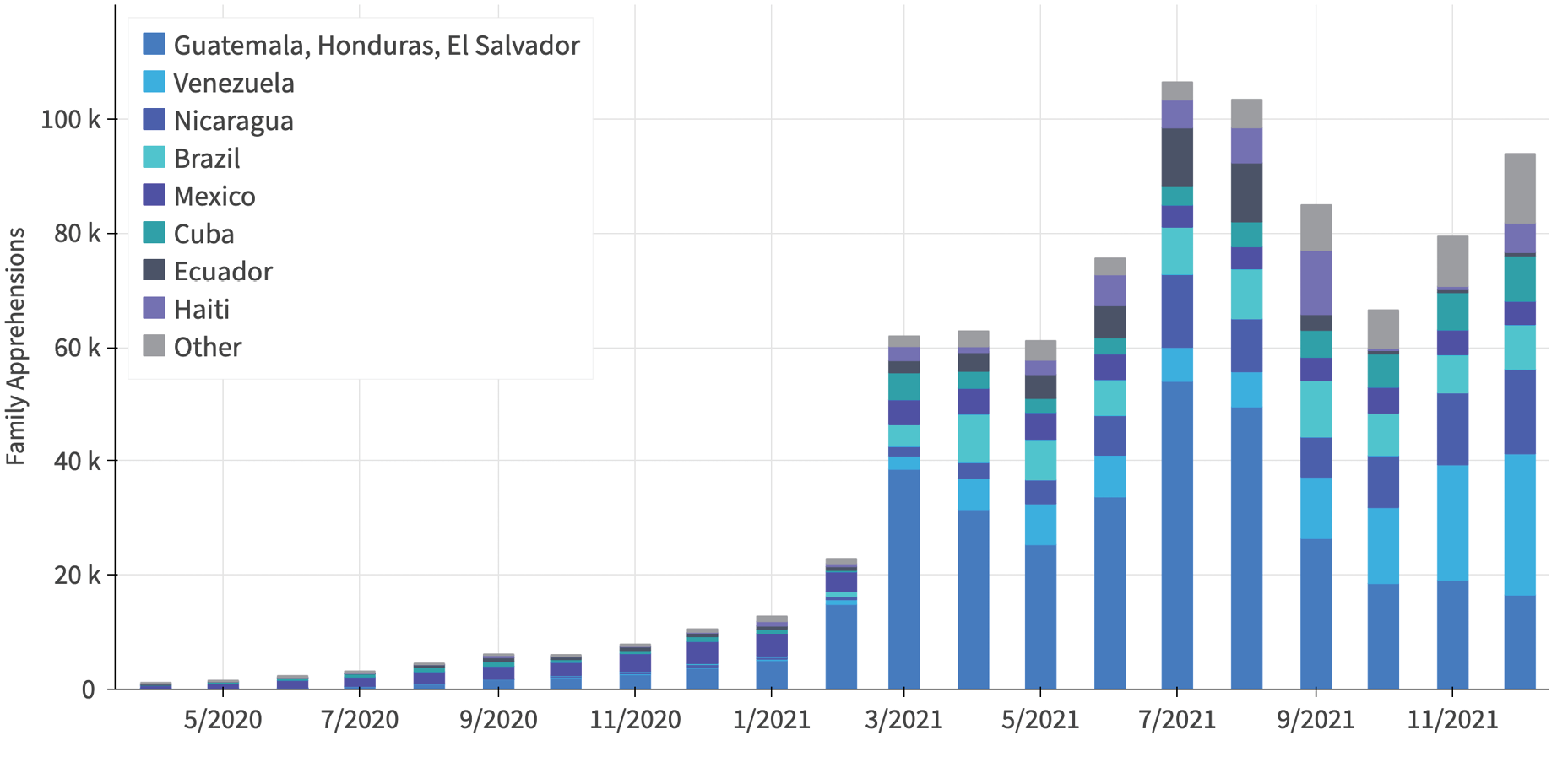
Source: U.S. Customs and Border Protection, Nationwide Border Encounters.
Thus, by the end of 2021, whether a person was allowed to seek asylum or was expelled largely came down to whether they arrived in a family group or whether they came from a country other than Mexico, Guatemala, Honduras, or El Salvador.
Throughout 2021, Few New Asylum Seekers Were Processed Through Ports of Entry
While asylum seekers who crossed the border improperly in 2021 came face to face with the arbitrary operation of Title 42, with some being allowed in and others expelled, those who sought asylum through the ports of entry were almost universally turned away. When the pandemic began in spring 2020, the ports of entry were, and largely remain, shut for asylum processing. From April 2020 through January 2021, CBP reported just 611 individuals were placed into the credible fear asylum process after seeking asylum at a port of entry, less than half of the 1,552 people placed into the credible fear asylum process in February 2020 alone.
After taking office, the Biden administration initially prioritized reopening the ports of entry to process individuals who had previously been placed into the Migrant Protection Protocols (also known as the Remain in Mexico program). By that point, tens of thousands of people in Mexico had been waiting in limbo for over a year, since court hearings had been suspended in March 2020.
Beginning in February 2021, the Biden administration began admitting through the ports of entry anyone with a pending MPP case. Those who entered via the ports of entry were required to register with the United Nations High Commissioner on Refugees and provide proof that they had recently tested negative for COVID. By mid-May, over 10,000 people formerly in MPP had been admitted through the ports of entry. Then in June, the Biden administration expanded eligibility for reentry to individuals placed into MPP who had been issued a deportation order for missing court, a common occurrence since many people had to run a gauntlet of kidnappers to make it to the courthouse door. However, this process ground to a halt in August, when a federal judge ruled that the MPP termination process had been improper, and ordered the Biden administration to restart MPP. No further individuals were admitted through the MPP wind-down process after that. In total, roughly 13,000 people were readmitted through the wind-down process.
Despite the infrastructure built up to admit those individuals previously returned to Mexico under MPP, the Biden administration only made marginal efforts to restart asylum processing at the ports of entry in 2021. Beginning in May, the Biden administration tapped a “consortium” of six groups at the border to help identify a small number of “vulnerable” individuals who could be admitted into the United States through humanitarian parole. But by the end of August, the consortium process broke down amid continued frustrations with the Biden administration’s refusal to end Title 42.
Even after the Biden administration formally lifted COVID-19 related travel restrictions at ports of entry in November, asylum seekers were still not permitted to seek protection. Similarly, in early November the Biden administration issued a new memo legally ending the Trump administration practice of “metering,” yet COVID-related restrictions on asylum processing continued and people showing up to a port of entry asking to access the asylum process continued to be turned away.
Due to this constellation of restrictive policies, individuals attempting to seek asylum without crossing the border between ports of entry remained largely unable to do so throughout 2021.
Record Apprehensions of Unaccompanied Children Posed Humanitarian Processing Challenges
Under U.S. law, an “unaccompanied child” is defined as a person under the age of 18 who arrives at the border without a parent or a formal legal guardian; meaning even a child who arrives at the border with another family member such as an aunt, uncle, or grandparent is still “unaccompanied” by law. Unaccompanied children from countries other than Mexico and Canada qualify for heightened legal protections to ensure that they are not the victims of trafficking, including the right to appear before an immigration judge rather than be subject to “expedited removal” at the border.
Since 2013, there have been periodic increases in the number of unaccompanied children arriving at our border and seeking protection, including in 2014, 2016, and 2019 (see Figure 11). In 2020, due to the COVID-19 pandemic, the number of unaccompanied children apprehended at the border dropped significantly to a low of 712 in April 2020. These figures began to rise again in the summer of 2020 and increased steadily through the fall, reaching 4,853 in December 2020.
Years of deterrence-based policies have not produced anything but short-term declines in the number of people seeking asylum while inflicting significant harm on families and children. The solution cannot be to turn people away and send them back to harm in their home countries. As the Biden administration continues to expel families back to Mexico, it cannot be forgotten that seeking asylum is legal. Solutions to the current situation at the border should not have “reducing numbers” as their primary goal, but instead should ensure the creation of a unified humanitarian approach for all groups—whether they are single adults, families, or children.
Figure 11: Unaccompanied Children Apprehended by the Border Patrol, October 2012 to December 2021
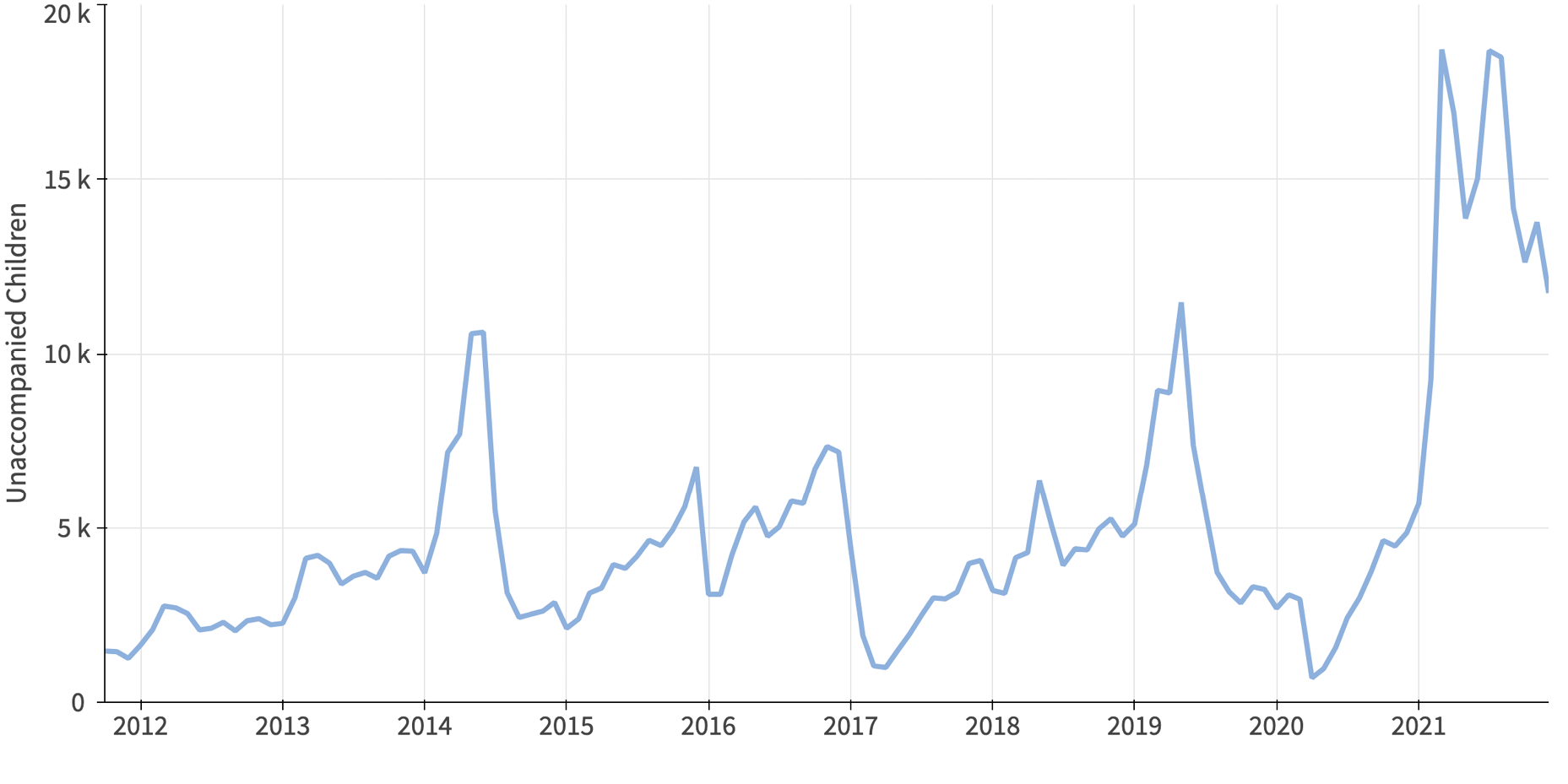
Source: U.S. Customs and Border Protection, Southwest Border Encounters.
After President Biden took office, significantly more unaccompanied children and families began arriving at the border. When a federal appeals court lifted the order halting CBP from expelling unaccompanied children on January 29, the Biden administration chose to keep the status quo in place by issuing a new order from the Centers for Disease Control and Prevention exempting unaccompanied children from Title 42.
The continued practice of expelling families also led some parents to make the agonizing decision to send their children across the border alone, knowing their child will be safer in the United States than waiting in Mexico. This also led to an increase in unaccompanied children crossing the border in 2021.
In March 2021, the number of unaccompanied children taken into CBP custody peaked at a record 18,951—significantly more than the previous record of 11,861 in May 2019—before dropping 25.3% by May to 14,158 and then rebounding slightly in June to 15,018. This increase in February and March caused an enormous bottleneck to build in CBP detention facilities because the government could not transfer the children to the Office of Refugee Resettlement (ORR) fast enough.
To get children out of CBP custody, the Biden administration began opening “emergency influx shelters” around the country, doubling ORR capacity within a matter of weeks. Unlike permanent shelters run by ORR, “emergency influx shelters” do not have to go through a state licensing process intended to ensure they are providing appropriate care for children.
This effort helped reduce the population of unaccompanied children in CBP custody from a high of 5,767 on March 28 to a low of 455 on May 10). The number of children in ORR custody then peaked at a record high of 22,557 on April 29, with more than half held in “emergency influx shelters.” Given the scale of the challenge, ORR struggled at first to find sufficient staff to carry out the background checks necessary to verify familial relationships and vet other sponsors, leading the Biden administration to ask for volunteers across the federal government to help process unaccompanied children. By the end of April, this effort began to pay off and the number of children in ORR custody began falling.
Throughout 2021, despite the number of unaccompanied children coming to the border periodically rising and falling, the number of children in federal custody never hit the same highs as in spring 2021 (see Figure 12). By the end of the year, the number of children in federal custody briefly dropped below 9,000, before rising again in the new year.
Figure 12: Unaccompanied Children Held in CBP and HHS ORR Custody, March 23, 2021–February 1, 2022
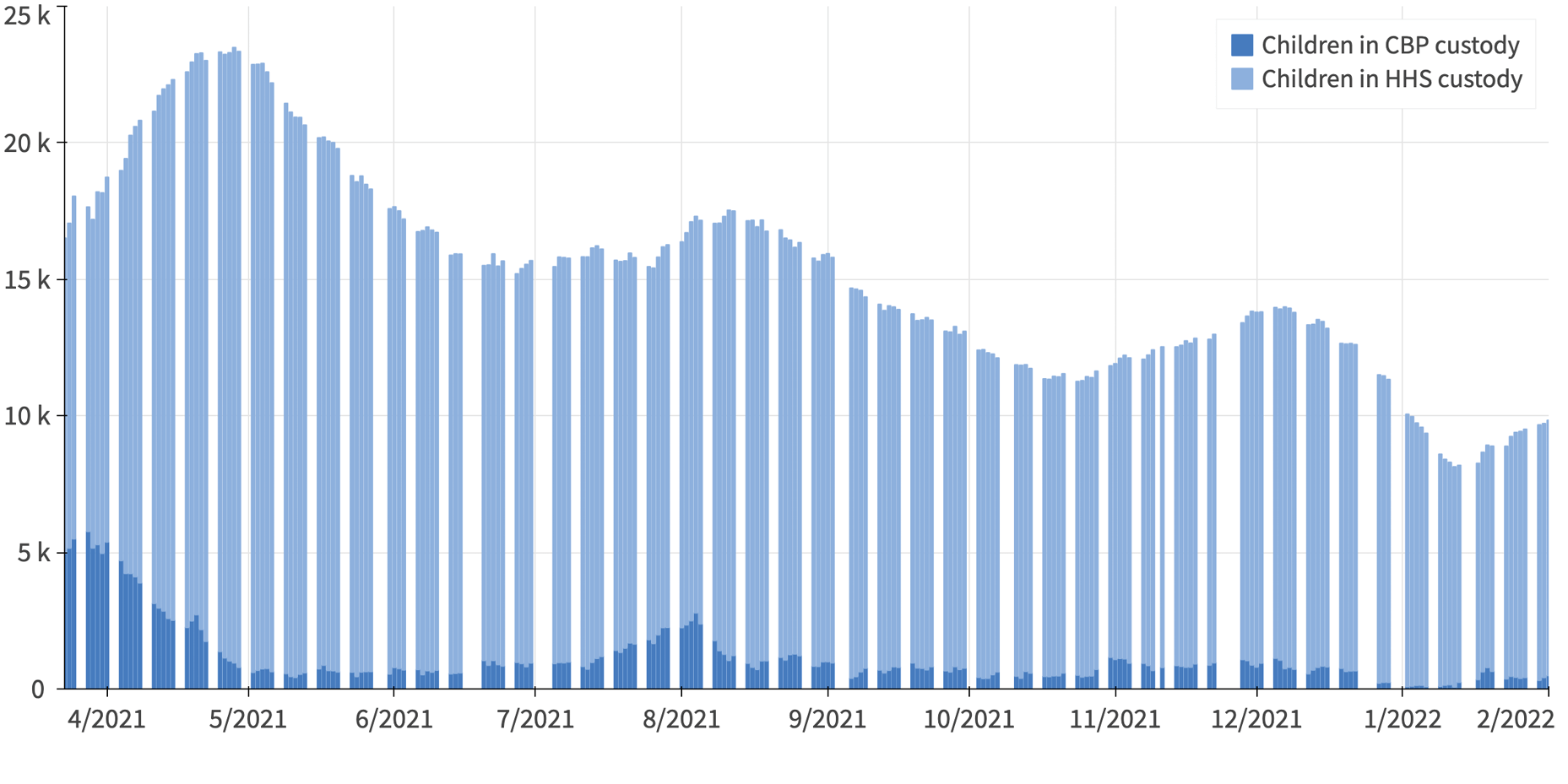
Source: Health and Human Services and Department of Homeland Security, Unaccompanied Children Daily Report (excludes children in transit from CBP to HHS). * Data not reported on these days.
Although the Biden administration made clear progress in reuniting unaccompanied children with sponsors inside the United States, conditions in “emergency influx shelters” continue to present a concern. While each shelter is different, at some locations children were held for weeks with little access to services or quality care. Advocates and children reported seriously inadequate conditions that led to children becoming suicidal or traumatized in many of these shelters, especially at the single largest shelter in existence, on Fort Bliss in El Paso, Texas.
Although the fate of unaccompanied children entering the United States is uncertain, data from DHS suggests that most would eventually be granted permission to remain. When considering all non-Mexican unaccompanied children—the group which is entitled to a hearing in court—who have arrived at the border since 2013, 57% of those whose cases were completed by mid-2020 were given permission to remain in the United States.
The Border Continues to Represent a Significant Humanitarian Challenge, Not a Security Challenge
Both the Obama and Trump administrations used harmful deterrence-based policies to try to prevent people from coming to the United States. Obama detained families and Trump separated families and sought to prevent asylum seekers from accessing protection in the United States by sending them into dangerous conditions in Mexico under MPP and through the institutionalized use of metering at ports of entry, as well as by issuing multiple rules designed to limit asylum eligibility.
These policies, which focused only on deterrence without providing any additional capacity to process those seeking humanitarian protection, have not worked in the long term. They temporarily suppressed arrivals, but the push factors in home countries and drivers of migration have remained. Within a few years of each punitive policy’s implementation, there was another increase in people coming to the border. What happened under Biden in 2021 was neither unique nor unprecedented.
There have been spikes in arrivals at the border in 2014, 2016, 2019, and now 2021. Even family separation in 2018 did not have a significant effect on border encounters, and the numbers of families arriving at the border in 2019 had already begun to decline before the MPP program went into full effect across the border. A new spike was inevitable. The only question was when it would occur.
Years of deterrence-based policies have not produced anything but short-term declines in the number of people seeking asylum while inflicting significant harm on families and children. The solution cannot be to turn people away and send them back to harm in their home countries. As the Biden administration continues to expel families back to Mexico, it cannot be forgotten that seeking asylum is legal. Solutions to the current situation at the border should not have “reducing numbers” as their primary goal, but instead should ensure the creation of a unified humanitarian approach for all groups—whether they are single adults, families, or children.
